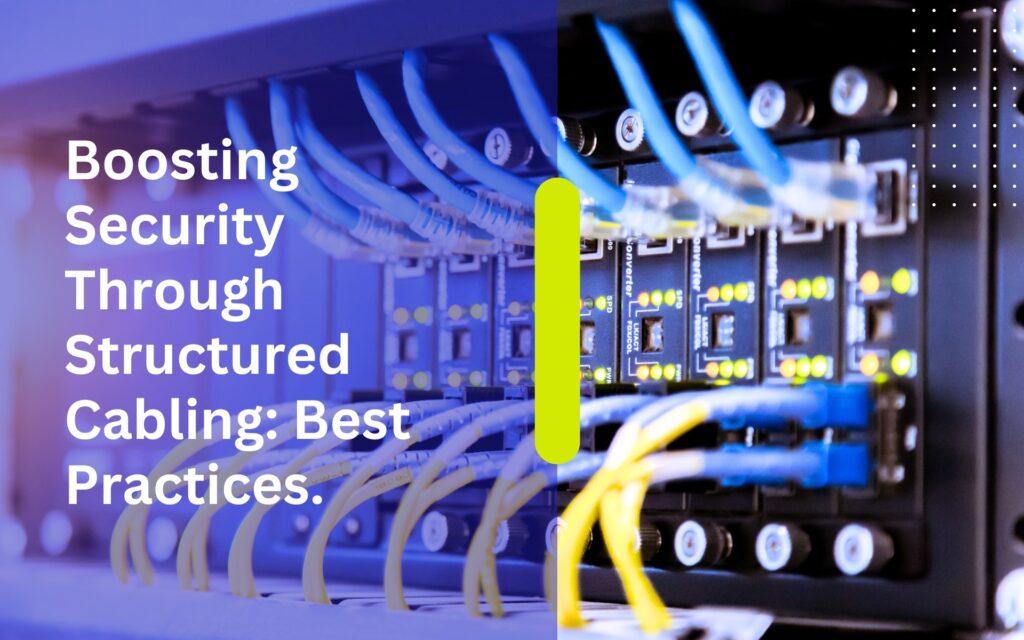InstallersPH Christmas Party 2025. Introduction. The Christmas season is a time that brings people together in the spirit of joy, gratitude, and celebration. For InstallersPH IT Solutions, the year 2025 marked another …
Boosting Security Through Structured Cabling: Best Practices.

Introduction
In today’s digital era, where data security is paramount, businesses must fortify their defenses against a myriad of cyber threats. While many focus on software solutions and network protocols, the importance of structured cabling in enhancing overall security often goes unnoticed. Structured cabling, when properly designed and implemented, not only optimizes network performance but also serves as a foundational element in bolstering security measures within an organization.
This extensive guide delves into the critical role of structured cabling in augmenting security and offers comprehensive best practices for businesses aiming to elevate their infrastructure security standards.
Elevating Security with Structured Cabling
In the realm of modern business operations, security is a non-negotiable aspect that demands meticulous attention and strategic planning. With cyber threats becoming increasingly sophisticated, organizations must adopt a proactive approach to safeguard their assets and data integrity. While various security measures are commonplace, the role of structured cabling in fortifying security infrastructure often remains underappreciated. This section explores how structured cabling serves as a cornerstone in elevating security standards within businesses.
Structured cabling embodies more than just a network connectivity solution; it forms the backbone of an organization’s communication infrastructure. By meticulously organizing and deploying cables in a structured manner, businesses not only optimize network performance but also mitigate security risks associated with haphazard cable arrangements. Here’s how structured cabling contributes to enhancing security:
1. Physical Security Fortification
Structured cabling entails the systematic organization and securing of cables within conduits or trays, mitigating risks of physical damage or tampering. This meticulous arrangement safeguards critical network infrastructure against unauthorized access or manipulation.
2. Access Control Implementation
Structured cabling facilitates the implementation of stringent access control mechanisms through the deployment of cabinets, racks, and patch panels. By restricting access to networking equipment and data cables, businesses can thwart unauthorized access attempts and safeguard sensitive information.
3. Seamless Surveillance Integration
Modern surveillance systems heavily rely on structured cabling to transmit high-definition video feeds across networks. By seamlessly integrating surveillance cameras with structured cabling infrastructure, organizations can enhance their security monitoring capabilities and deter potential threats effectively.
4. Enhanced Redundancy and Resilience
Structured cabling permits the deployment of redundancy and resilience measures, including redundant pathways and failover mechanisms. These redundancies ensure uninterrupted operations in the face of cable failures or network disruptions, thereby fortifying overall security and operational continuity.
Comprehensive Best Practices for Secure Structured Cabling
To harness the full spectrum of security benefits offered by structured cabling, businesses should adhere to a meticulous set of best practices:
1. Conduct Thorough Risk Assessments
Prior to designing a structured cabling system, conduct comprehensive risk assessments to identify potential security vulnerabilities and threat vectors. This proactive evaluation enables organizations to tailor their cabling infrastructure to mitigate specific security concerns effectively.
2. Adhere to Industry Standards
Ensure adherence to industry standards and guidelines prescribed by entities like the Telecommunications Industry Association (TIA) and the International Organization for Standardization (ISO). Compliance with these rigorous standards guarantees that the structured cabling system meets stringent security and performance requirements.
3. Deploy Robust Physical Security Measures
Deploy robust physical security measures, such as secured cabinets, access control systems, and surveillance cameras, to safeguard networking equipment and cable infrastructure against unauthorized access or tampering.
4. Implement Robust Cable Encryption Protocols
Leverage advanced encryption technologies to secure data transmitted over structured cabling networks. Implementing robust encryption protocols like Transport Layer Security (TLS) or IPsec adds an additional layer of security, thwarting eavesdropping and data interception attempts effectively.
5. Embrace Regular Maintenance and Monitoring
Conduct routine maintenance and monitoring of the structured cabling system to proactively detect and address potential security threats. This includes regular cable inspections, firmware and software updates, and proactive monitoring of network traffic for anomalous activity.
6. Prioritize Employee Training and Awareness
Educate employees about the significance of security protocols and best practices associated with structured cabling. Provide comprehensive training on identifying potential security threats, adhering to proper cable management practices, and promptly reporting suspicious activities.
7. Engage Experienced Professional Partnerships
Collaborate with seasoned professionals possessing extensive expertise in designing and implementing structured cabling systems. Partnering with reputable vendors ensures that the cabling infrastructure is installed correctly and in full compliance with prevailing security standards and regulations.
Conclusion
Structured cabling stands as a linchpin in not only optimizing network performance but also fortifying the security posture of modern organizations. By meticulously adhering to best practices and harnessing structured cabling technologies effectively, businesses can elevate their security standards, mitigate risks, and safeguard critical assets against evolving threats.
Investing in secure structured cabling today is not just an operational necessity but a strategic imperative to future-proof your organization against the ever-evolving landscape of cybersecurity threats. Embrace structured cabling as a cornerstone of your security infrastructure and fortify your organization’s resilience against potential adversities.
Related Articles
The On-the-Job Training Experience of Mark Edwin E. Huyo-a Introduction On-the-Job Training (OJT) serves as one of the most significant components of an Information Technology student’s academic journey. It bridges the gap …
The On-the-Job Training Experience of Gester Samson. Introduction. The On-the-Job Training journey marks a crucial stage for students as they step into real work environments and apply what they have learned in …


